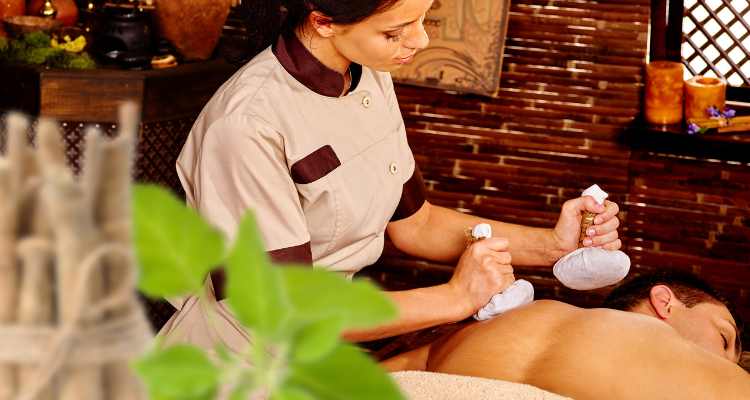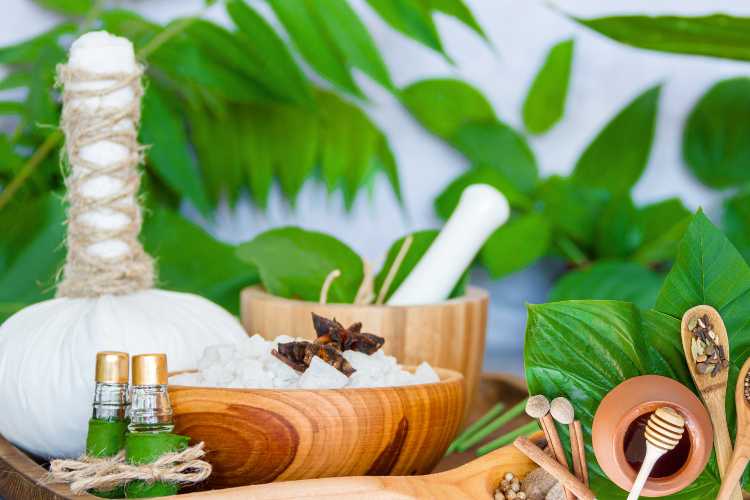Ayurvedic Treatment for Osteoarthritis in Coimbatore
Best Ayurvedic Treatment for Osteoarthirtis in Coimbatore
Ayurvedic treatment for Osteoarthritis combines herbal remedies, Panchakarma therapies, lifestyle adjustments, and dietary guidance. Ayurveda provides a holistic and natural approach to managing Osteoarthritis. It doesn’t just target the symptoms; it aims to restore balance within the body.

Pure Herbal

Evidence Based

Guranteed Results
Book An Ayurvedic Treatment for Osteoarthritis in Coimbatore.
If you are looking for an Ayurvedic Treatment for Osteoarthritis in Coimbatre Book an appointment and get free consultation.
What is included in Our Ayurvedic Treatment for Osteoarthritis?
- Detailed In-Patient Health Assessment: An in-depth evaluation of presenting complaints, history, underlying causative factors, and disease pathways using specialized ayurvedic as well as modern diagnostic techniques
- Personalized Treatment Protocol: A combination of personalized therapies, herbal remedies, dietary adjustments, and lifestyle changes based on the in person analysis.
- Pain scale Assessment: Daily assessment of pain scale to record the outcome
- Herbal Medicines: Carefully selected Ayurvedic herbs that can reduce inflammation, alleviate pain, and promote joint health.
- Panchakarma: Detoxification and rejuvenation therapies, such as Abhyanga (massage), Swedana (herbal steam), and Basti (herbal enema), to cleanse the body and remove accumulated toxins.
- Yoga and Exercise: Diseases and patient centric yogic protocols to improve joint flexibility, strength, and circulation.
- Dietary Guidance: Recommendations on what foods to eat, avoid, and how to prepare meals to support joint health.
- Lifestyle Modifications: Advice on stress management, sleep hygiene, and daily routines to promote overall well-being.
Aim of Avanika's Ayurvedic Treatment Package for Osteoarthritis
- Reduce pain and inflammation
- Improve joint flexibility and mobility
- Reverse the pathogenesis by slowing down joint degeneration
- Strengthen joints and surrounding tissues to improve joint stability and function.
- Balance Vata Dosha: To address the root cause of the condition in Ayurveda (explained later).
- Enhance Overall Well-being: To promote physical and mental health, improving quality of life.

Benefits of Avanika's Ayurvedic Treatment Package for Osteoarthritis
- Natural Approach: Using herbal remedies and therapies that are gentle on the body.
- Personalized Care: Tailoring treatments to your unique needs and constitution.
- Holistic Healing: Addressing the underlying causes of the condition, rather than just masking the symptoms.
- Long-Term Relief: Promoting long-term health and well-being through lifestyle adjustments.
- Fewer Side Effects: Avoiding the adverse effects associated with some conventional medications.
- Improved Overall Health: Enhancing energy levels, digestion, sleep, and mental clarity.
- Empowerment: Taking an active role in your health and learning how to manage your condition.

What are the symptoms of Osteoarthritis?
Osteoarthritis, also known as osteoarthrosis or degenerative joint disease, is caused mainly by wear and tear of the joints.
- The knees, cervical spine, lumbar spine, hips, shoulders and finger joints are affected most frequently.
- Nodule formation on finger joints which may become painful
- Vague pain and stiffness in the knee especially after getting up from the sitting posture
- Disability while walking down the stairs or slopes
- Pain when pressure is applied to the joint
- Creaking or clicking sound when the joint moves
- Difficulty moving joints through their full range
- Stiffness especially in the morning or after periods of inactivity
- Affection of lumbar spine leads to low back ache and sciatica.
What are the causes of Osteoarthritis?
- Familial history
- Overuse of joints
- Ageing
- Change in chemical characteristics of the ground substance
- Pre Existing joint disease
- Obesity
- Hypermobility
- Orthopedic deformities
- Endocrine disorders like diabetes mellitus, acromegaly, hyperparathyroidism, sensory neuropathies that impair joint sensations
Risk factors
- Older Age: The most significant risk factor.
- Gender: Women are more prone to Osteoarthritis than men, especially after menopause.
- Family History: Genetic predisposition.
- Obesity: Excess weight.
- Previous Joint Injury: Including fractures, dislocations, and ligament tears.
- Repetitive Joint Use: Common in athletes or those in specific professions.
- Certain Medical Conditions: Like rheumatoid arthritis or joint infections.
- Bone deformities: Bony lumps like osteophyte or heberden’s nodes or abnormal cartilage
Ayurvedic Perspective
- Detailed In-Patient Health Assessment: An in-depth evaluation of presenting complaints, history, underlying causative factors, and disease pathways using specialized ayurvedic as well as modern diagnostic techniques
- Personalized Treatment Protocol: A combination of customized therapies, herbal remedies, dietary adjustments, and lifestyle changes based on the in-person analysis.
- Pain scale Assessment: Daily assessment of pain scale to record the outcome
- Herbal Medicines: Carefully selected Ayurvedic herbs that can reduce inflammation, alleviate pain, and promote joint health.
- Panchakarma: Detoxification and rejuvenation therapies, such as Abhyanga (massage), Swedana (herbal steam), and Basti (herbal enema), to cleanse the body and remove accumulated toxins.
- Yoga and Exercise: Diseases and patient centric yogic protocols to improve joint flexibility, strength, and circulation.
- Dietary Guidance: Recommendations on what foods to eat, avoid, and how to prepare meals to support joint health.
- Lifestyle Modifications: Advice on stress management, sleep hygiene, and daily routines to promote overall well-being.
Ayurvedic treatment for Osteoarthritis in Coimbatore
Since Osteoarthritis is a vata-dominant disease with bone tissue being the principal component, nourishing and strengthening therapies are the main line of treatment.
Asthisaravardana drugs have special importance. The administration of milk and ghee processed with bitter drugs is especially important here.
Along with bone tissue dhatu, the other components indirectly related to Osteoarthritis, like muscles, vessels, tendons etc, are to be empowered by proper oleation, sudation, and strengthening treatments
Panchakarma Chikitsa
Panchakarma chikitsa is mainly done before brahmana and balya chikitsa in Osteoarthritis. Snehapana with ghrithas and thailas is done before virechana. Generally, snigdha virechana is opted for to prevent further vathakopa.
- Abhyanga (Massage): Warm, medicated oil massage to nourish tissues and reduce pain.
- Swedana (Herbal Steam): Promotes sweating to help remove toxins.
- Vasti (Enema): Herbal enemas are used to balance Vata dosha. Vasthi is very much essential in Osteoarthritis to check the progression of joint degeneration. Thiktharasa Ksheera Vasthi is the most preferred one.
- Janu Basti: A localised oil treatment curated for knee joints.
- Greeva Basti: A localised oil treatment curated for cervical joints.
- Prushta Basti: A localised oil treatment curated for vertebrae.
- Patra Pinda Sweda: Herbal poltice dipped in warm medicated oil is massaged over the affected area or whole body
External applications
Lepana (Herbal paste): Application of medicated paste over the affected joints. Here are few commonly used preparations:
- Tila and satahwa boiled in milk
- Nagaradi lepa choorna with Krishnadi gulika mixed with sigru swarasa in sopha stages
- Nagaradilepa choorna with chinchapatra swarasa
Thaila abhyanga: A medicated oil massage with the following oils are found beneficial in Osteoarthritis
1. Kethakimooladi Thaila
2. Bala Thaila
3. Murivenna
4. Karpooradi Thaila
Parisheka: Lukewarm liquids/oils are poured over the entire body/localised affected area to ease pain
1. Parisheka with Yamaka sneha
2. Parisheka with Maha sneha
Herbal Remedies:
- Shallaki (Boswellia serrata): Known for its anti-inflammatory properties.
- Guggulu (Commiphora mukul): Helps reduce inflammation and improve joint mobility.
- Ashwagandha (Withania somnifera): Reduces pain, improves joint function, and provides strength to the joints.
- Turmeric (Curcuma longa): Contains curcumin, a powerful anti-inflammatory agent.
- Ginger (Zingiber officinale): Helps reduce pain and inflammation.
- Triphala: A combination of three fruits that helps with detoxification and digestion.
Yoga and Exercise:
- Gentle Yoga Poses: Yoga poses specifically curated for osteoarthritis patients helps improve flexibility, strength, and balance.
- Walking and Swimming: Low-impact exercises that are gentle on the joints.
- Tai Chi: Promotes balance and flexibility.
Pain Management Therapies:
- Agni Karma (Heat Therapy): Using specially crafted panchaloha shalaka to reduce pain and inflammation.
- Lepa (Herbal Paste): Application of herbal paste on affected joints.
Lifestyle Recommendations for Osteoarthritis Patients
Making healthy lifestyle changes is crucial in managing Osteoarthritis:
- Engage in regular low-impact exercises to strengthen muscles and support joints.
- Maintain a healthy weight, this can significantly decrease pressure on the joints.
- Practice good posture while sitting, standing, and walking to minimize joint strain.
- Practice meditation, deep breathing, or other relaxation techniques to reduce stress, as stress can aggravate pain.
- Aim for 7-9 hours of quality sleep per night.
- Avoid overexertion to prevent joint stress.
- Balance periods of activity with periods of inactivity.
Diet During Ayurvedic Treatment for Osteoarthritis
Diet plays a key role in managing Osteoarthritis. Ayurveda recommends:
Foods to Consume:
- Anti-inflammatory Foods: Turmeric, ginger, garlic, leafy greens, and berries.
- Nourishing Warm Foods: Easy to digest and reduce Vata aggravation.
- Healthy Fats: Like ghee, and coconut oil.
- Whole Grains: Like brown rice, and moong dal.
- Fruits: Like Pomegranate, gooseberry and dried grapes
- Vegetables: Like bitter gourd, bottle gourd, cauliflower, coriander etc
Foods to Avoid:
- Cold and Dry Foods: Like ice cream, curd, dehydrated foods can aggravate Vata dosha.
- Processed and Packaged Foods: Often contain unhealthy additives that can contribute to inflammation.
- Red Meat: Can exacerbate inflammation.
- Nightshades: Like tomatoes, potatoes, and eggplant, can cause discomfort in some individuals.
- Sugary Drinks and Processed Sugars: Contribute to inflammation.
- Hydration: Drink plenty of warm water throughout the day to help flush out toxins.
- Eat Mindfully: Enjoy meals in a peaceful setting without distractions to promote better digestion.
- Follow Meal Schedule: Eat at regular intervals to support balanced energy levels.
How to Prevent Osteoarthritis in Natural Way?
While some risk factors cannot be changed, there are steps you can adopt to prevent or slow down the progression of generalised joint pain to serious issues like Osteoarthritis:
- Practice strength training exercises to support joints and surrounding structures
- Maintain a healthy weight
- Prevent excess strain on joints.
- Practice good posture
- Be mindful while lifting heavy objects
- Use protective padding or braces during sports or activities.
- Include nutrient-rich foods that support joint health.
- Avoid overexertion and rest when needed.
- Address other health issues like inflammation in a timely; otherwise, it can worsen joint health.
What are you waiting for...
Book an Appointment
Hours & Contact
28A Bharathi Park 7th Cross, Saibaba Colony, Coimbatore
641043
+9142229 69555
+9189039 69555
info@avanikaayurvedic.com
Open All Days 7:00 AM -7:00 PM
